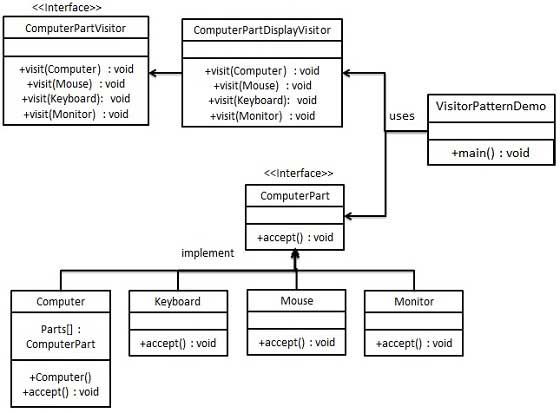- 设计模式-访客模式
- 设计模式-主页
- 设计模式-概述
- 设计模式-工厂模式
- 抽象工厂模式
- 设计模式-Singleton模式
- 设计模式-生成器模式
- 设计模式-原型模式
- 设计模式-适配器模式
- 设计模式-桥梁模式
- 设计模式-过滤器模式
- 设计图案-复合图案
- 设计图案-装饰图案
- 设计图案-立面图案
- 设计图案-飞线图案
- 设计模式-代理模式
- 责任链模式
- 设计模式-命令模式
- 设计模式-解释器模式
- 设计模式-迭代器模式
- 设计模式-中介模式
- 设计模式-Memento模式
- 设计模式-观察者模式
- 设计模式-状态模式
- 设计模式-空对象模式
- 设计模式-战略模式
- 设计模式-模板模式
- 设计模式-访客模式
- 设计模式-MVC模式
- 业务代表模式
- 复合实体模式
- 数据访问对象模式
- 前控制器模式
- 拦截过滤器模式
- 服务定位器模式
- Java传输对象模式
设计模式-访客模式
In Visitor pattern, we use a visitor class which changes the executing algorithm of an element class. By this way, execution algorithm of element can vary as and when visitor varies. This pattern comes under behavior pattern category. As per the pattern, element object has to accept the visitor object so that visitor object handles the operation on the element object.
Implementation
We are going to create a ComputerPart interface defining accept opearation.Keyboard, Mouse, Monitor and Computer are concrete classes implementing ComputerPart interface. We will define another interface ComputerPartVisitor which will define a visitor class operations. Computer uses concrete visitor to do corresponding action.
VisitorPatternDemo, our demo class, will use Computer and ComputerPartVisitor classes to demonstrate use of visitor pattern.

Step 1
Define an interface to represent element.
ComputerPart.java
public interface ComputerPart {
public void accept(ComputerPartVisitor computerPartVisitor);
}
Step 2
Create concrete classes extending the above class.
Keyboard.java
public class Keyboard implements ComputerPart {
@Override
public void accept(ComputerPartVisitor computerPartVisitor) {
computerPartVisitor.visit(this);
}
}
Monitor.java
public class Monitor implements ComputerPart {
@Override
public void accept(ComputerPartVisitor computerPartVisitor) {
computerPartVisitor.visit(this);
}
}
Mouse.java
public class Mouse implements ComputerPart {
@Override
public void accept(ComputerPartVisitor computerPartVisitor) {
computerPartVisitor.visit(this);
}
}
Computer.java
public class Computer implements ComputerPart {
ComputerPart[] parts;
public Computer(){
parts = new ComputerPart[] {new Mouse(), new Keyboard(), new Monitor()};
}
@Override
public void accept(ComputerPartVisitor computerPartVisitor) {
for (int i = 0; i < parts.length; i++) {
parts[i].accept(computerPartVisitor);
}
computerPartVisitor.visit(this);
}
}
Step 3
Define an interface to represent visitor.
ComputerPartVisitor.java
public interface ComputerPartVisitor {
public void visit(Computer computer);
public void visit(Mouse mouse);
public void visit(Keyboard keyboard);
public void visit(Monitor monitor);
}
Step 4
Create concrete visitor implementing the above class.
ComputerPartDisplayVisitor.java
public class ComputerPartDisplayVisitor implements ComputerPartVisitor {
@Override
public void visit(Computer computer) {
System.out.println("Displaying Computer.");
}
@Override
public void visit(Mouse mouse) {
System.out.println("Displaying Mouse.");
}
@Override
public void visit(Keyboard keyboard) {
System.out.println("Displaying Keyboard.");
}
@Override
public void visit(Monitor monitor) {
System.out.println("Displaying Monitor.");
}
}
Step 5
Use the ComputerPartDisplayVisitor to display parts of Computer.
VisitorPatternDemo.java
public class VisitorPatternDemo {
public static void main(String[] args) {
ComputerPart computer = new Computer();
computer.accept(new ComputerPartDisplayVisitor());
}
}
Step 6
Verify the output.
Displaying Mouse. Displaying Keyboard. Displaying Monitor. Displaying Computer.